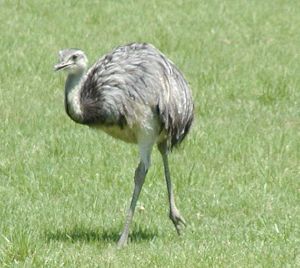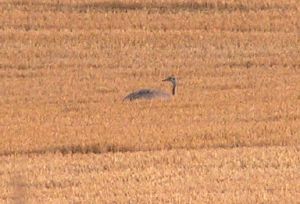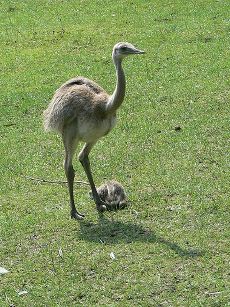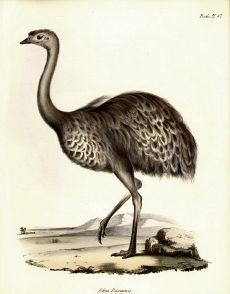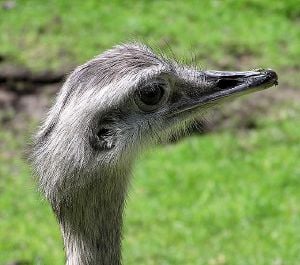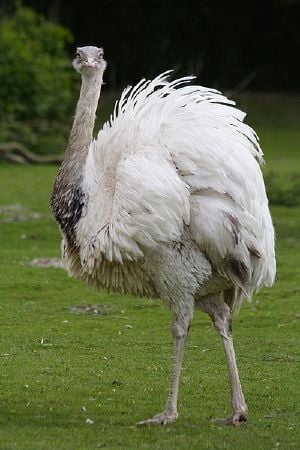Rhea (bird)
| Rhea
| ||||||||||||||
|---|---|---|---|---|---|---|---|---|---|---|---|---|---|---|
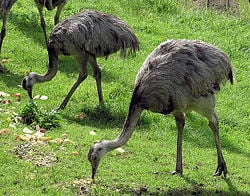 American Rhea, Rhea americana
| ||||||||||||||
| Scientific classification | ||||||||||||||
| ||||||||||||||
|
Rhea is the common name for any of the large, flightless, ratite birds comprising the genus Rhea, characterized by a body with large legs, a long neck, and three-toed feet. Native to South America, the rheas resemble the ostriches of Africa and the emus of Australia. There are two existing species of rhea: the greater or American rhea (R. americana) and the lesser or Darwin's rhea (R. pennata).
Description
Rheas are members of a group of birds known was ratites. Ratites are flightless birds characterized by a flat, raft-like sternum (breastbone) lacking the keel for attachment of wing muscles that is typical of most flying birds and some other flightless birds. Other ratites are the similar-looking and fast-running emus of Australia and ostriches of Africa, as well as the much smaller kiwis of New Zealand. The ostrich is the largest living species of bird (reaching 9 feet) and the emu is the second-largest extant bird in the world (reaching 6.5 feet in height).
Rheas are large birds with gray-brown plumage, long legs, and long necks. These birds can reach 5.6 feet (1.7 meters) in height, and weigh up to 88 pounds (40 kilograms).[2][3] Their wings are large for a flightless bird and are spread while running, to act like sails.[4] Unlike most birds, rheas have only three toes. The emu also has three toes, but the ostrich has only two toes. A rhea's tarsus has horizontal plates on the front of it. They also store urine separately in an expansion of the cloaca.[3]
Taxonomy
Although the shared shape of the breastbone of ratites is considered by many authorities to be more a product of adaptation to living on the ground rather than shared ancestry, others assume shared ancestry and place the ratites together. A current approach is to combine them as different families within the order Struthioniformes, with rheas in the family Rheidae, ostriches in the family Struthionidae, and emus in the family Casuariidae. However, an alternative classification places the rheas in the order Rheiformes, the emus in the order Casuariiformes, and the ostriches remaining in Struthioniformes.
The genus name Rhea was given in 1752 by Paul Möhring and adopted as the English common name. In classical mythology, Rhea is the daughter of Uranus, the sky, and Gaia, the earth, and was known as "the mother of gods." Möhring's reason for choosing this name is not known.
The two recognized extant species are:
- Greater rhea Rhea americana (Argentina, Bolivia, Brazil, Paraguay, Uruguay)
- Lesser rhea Rhea pennata (Argentina, Bolivia, Chile, Peru)
The greater rhea, Rhea americana, derives its name from the Latin form of America.[5] It was originally described by Carolus Linnaeus[3] in his 18th-century work, Systema Naturae. He identified specimens from Sergipe, and Rio Grande do Norte, Brazil, in 1758.[3]
Darwin's rhea, Rhea pennata, gets its scientific name from the Greek goddess and pennata means winged. The specific name was bestowed in 1834 by Charles Darwin's contemporary and rival Alcide d'Orbigny, who first described the bird to Europeans, from a specimen from the lower Río Negro south of Buenos Aires, Argentina.[3][6]
Rhea pennata was not always in the Rhea genus. As late as 2008 it was classified in the monotypic genus Pterocnemia. This word is formed from two Greek words pteron meaning feathers, and knēmē meaning the leg between the knee and the ankle, hence feather-legged, alluding to their feathers that cover the top part of the leg.[7] In 2008, the [[American Ornithologists' Union (SACC) subsumed Pterocnemia into the genus Rhea.[8] This merging of genera leaves only the Rhea genus.[9] A
A third species of rhea, Rhea nana, was described by Lydekker in 1894 based on a single egg found in Patagonia,[10] but today no major authorities consider it valid.
Subspecies
There are five subspecies of the greater rhea, which are difficult to distinguish and whose validity is somewhat unclear; their ranges meet around the Tropic of Capricorn:[11]
- R. americana americana – campos of northern and eastern Brazil[12].
- R. americana intermedia – Uruguay and extreme southeastern Brazil (Rio Grande do Sul province)[12].
- R. americana nobilis – eastern Paraguay, east of Rio Paraguay[12].
- R. americana araneipes – chaco of Paraguay and Bolivia and the Mato Grosso province of Brazil[12].
- R. americana albescens – plains of Argentina south to the Rio Negro province.[12]
Main subspecific differences are the extent of the black coloring of the throat and the height. However, rheas differ so little across their range that without knowledge of the place of origin it is essentially impossible to identify captive birds to subspecies.[11]
There are three subspecies of the lesser rhea:
- R. pennata garleppi – found in the puna of southeastern Peru, southwestern Bolivia, and northwestern Argentina.[12]
- R. pennata tarapacensis – found in the puna of northern Chile from the region of Arica and Parinacota to Antofagasta.[13]
- R. pennata pennata – found in the Patagonian steppes of Argentina and Chile.[14][12]
It has been suggested that the two northern taxa R. p. tarapacensis and R. p. garleppi should be considered a separate species, the Puna rhea (R. tarapacensis, with garleppi as a subspecies).[13] Both garleppi and tarapacensis were described by Charles Chubb in 1913.[1] It is possible garleppi should be considered a junior synonym of tarapacensis.
Behavior and ecology
Individual and flocking
Rheas tend to be silent birds with the exception being when they are chicks or when the male is seeking a mate. During the non-breeding season they may form flocks of between 10 and 100 birds, although the lesser rhea forms smaller flocks than this. When in danger they flee in a zig-zag course, utilizing first one wing then the other, similar to a rudder. During breeding season the flocks break up.[3]
Diet
They are omnivorous and prefer to eat broad-leafed plants, but also eat seeds, roots, fruit, lizards, beetles, grasshoppers, and carrion.[3]
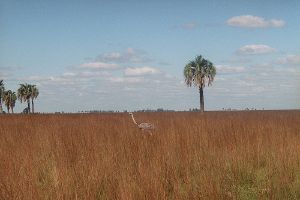
The bulk of the food of the greater rhea consists of broad-leaved dicot foliage and other plant stuffs, particularly seed and fruit when in season. Favorite food plants include native and introduced species from all sorts of dicot families, such as Amaranthaceae, Asteraceae, Bignoniaceae[15], Brassicaceae, Fabaceae[16], Lamiaceae[17], Myrtaceae[18] or Solanaceae[19]. Magnoliidae fruit, for example of Duguetia furfuracea (Annonaceae) or avocados (Persea americana, Lauraceae) can be seasonally important. They do not usually eat cereal grains, or monocots in general. However, the leaves of particular grass species like Brachiaria brizantha can be eaten in large quantities, and Liliaceae (e.g. the sarsaparilla Smilax brasiliensis) have also been recorded as food plants. Even tough and spiny vegetable matter like tubers or thistles is eaten with relish. Like many birds that feed on tough plant matter, the greater rhea swallows pebbles, which help grind down the food for easy digestion. It is much attracted to sparkling objects and sometimes accidentally swallows metallic or glossy objects.[11][20]
In fields and plantations of plants they do not like to eat—such as cereals or Eucalyptus—the greater rhea can be a species quite beneficial to farmers. It will eat any large invertebrate it can catch; its food includes locusts and grasshoppers, true bugs, cockroaches, and other pest insects. Juveniles eat more animal matter than adults. In mixed cerrado and agricultural land in Minas Gerais (Brazil), R. a. americana was noted to be particularly fond of beetles. It is not clear whether this applies to the species in general, but, for example, in pampas habitat, beetle consumption is probably lower simply due to availability while Orthoptera might be more important. The greater rhea is able to eat Hymenoptera in quantity. These insects contain among them many who can give painful stings, though the birds do not seem to mind. It may be that this species has elevated resistance to poison, as it readily eats scorpions. But even small vertebrates like rodents, snakes, lizards, and small birds are eaten. Sometimes, greater rheas will gather at carrion to feed on flies; they are also known to eat dead or dying fish in the dry season, but as with vertebrate prey in general not in large quantities.[11][20]
Reproduction
Rheas are polygamous: Males are simultaneously polygynous, females are serially polyandrous. In practice, this means that the females move around during breeding season, mating with a male and depositing their eggs with the male before leaving him and mating with another male. The polygynous males may court between two and twelve females. After mating, the male builds a nest, in which each female lays her eggs in turn. The nests are thus collectively used by several females. The males, which are sedentary after mating, attend the nests with the eggs of the several females and take care of incubation and the hatchlings all on their own. Recent evidence suggests that dominant males may enlist a subordinate male to roost for him while he starts a second nest with a second harem.[3] Greater rheas breed in the warmer months, between August and January depending on the climate.
The rhea nest consists of a simple and wide scrape in the ground, lined with grass and leaves.[4] The nest is kept in a hidden location; males will drag sticks, grass, and leaves in the area surrounding the nest so it resembles a firebreak as wide as their neck can reach.
The male incubates from ten to eighty eggs. The nests of greater rheas can contain as many as 80 eggs laid by a dozen females; each individual female's clutch numbers some 5-10 eggs.[11] However, the average clutch size of the greater rhea is 26 with 7 different females eggs.[3] Greater rhea eggs measure about 130 millimeters × 90 millimeters (5.1 inches × 3.5 inches) and weigh 600 grams (21 ounces) on average; they are thus less than half the size of an ostrich egg. Their shell is greenish-yellow when fresh but soon fades to dull cream when exposed to light.
The male will utilize a decoy system and place some eggs outside the nest and sacrifice these to predators, so that predators do not attempt to get inside the nest. While caring for the young, the males will charge at any perceived threat that approach the chicks including female rheas and humans.
The incubation period is 29–43 days. All the eggs hatch within 36 hours of each other even though the eggs in one nest were laid perhaps as much as two weeks apart.[3] As it seems, when the first young are ready to hatch they start a call resembling a pop-bottle rocket, even while still inside the egg; thus the hatching time is coordinated. Greater rheas are half-grown about three months after hatching, full adult size in about six months, and sexually mature by their 14th month, but do not breed until they reach two years of age.[4]
Predators
The natural predators of adult greater rheas are limited to the cougar (Puma concolor) and the jaguar (Panthera onca). Feral dogs are known to kill younger birds, and the Southern caracara (Caracara plancus) is suspected to prey on hatchlings. Armadillos sometimes feed on greater rhea eggs; nests have been found that had been undermined by a six-banded armadillo (Euphractus sexcinctus) or a big hairy armadillo (Chaetophractus villosus) and the rhea eggs were broken apart.[21]
Captive-bred greater rheas exhibit significant ecological naïvete. This fearlessness renders them highly vulnerable to predators if the birds are released into the wild in reintroduction projects. Classical conditioning of greater rhea juveniles against predator models can prevent this to some degree, but the personality type of the birds—whether they are bold or shy—influences the success of such training. In 2006, a protocol was established for training greater rheas to avoid would-be predators, and for identifying the most cautious animals for release.[22]
Uses by humans
Rheas have many uses in South America. Feathers are used for feather dusters, skins are used for cloaks or leather, and their meat is a staple to many people.[3]
The greater rhea is farmed in North America and Europe, similar to the emu and ostrich. The main products are meat and eggs, but rhea oil is used for cosmetics and soaps, and rhea leather is also traded in quantity. Male greater rheas are very territorial during the breeding season. The infant chicks have high mortality in typical confinement farming situations, but under optimum free-range conditions, chicks will reach adult size by their fifth month.
Conservation
Darwin's Rhea is Near Threatened, with the primary threats being hunting, egg-collecting, and fragmentation of its habitat due to conversion to farmland or pastures for cattle-grazing.[14][3] The total range is estimated at 1,100,000 km² (420,000 sq mi).[23] The southern nominate subspecies remains relatively widespread and locally fairly common, but the situation for the two northern subspecies is more worrying, with their combined population estimated as being in the hundreds.[14]
The Greater Rhea is considered a Near Threatened species according to the IUCN. The species is believed to be declining but it is still reasonably plentiful across its wide range,[24] which is about 6,540,000 km² (2,530,000 sq mi). The major factors in its decline is ranching and farming.[25]
Farmers sometimes consider them pests, because they will eat broad-leaved crop plants, such as cabbage, chard and bok choi, although if very hungry, soybean leaves will do. Rheas disdain grasses unless there are no other options. Where they occur as pests, farmers tend to hunt and kill Greater Rheas. This, along with egg-gathering and habitat loss, has led to the population decline. The habitual burning of crops in South America has also contributed to their decline. Moreover, the birds' health is affected by wholesale pesticide and herbicide spraying; while not threatening on a large scale, locally the species may be seriously affected by poisoning.
International trade in wild-caught Greater Rheas is restricted as per CITES Appendix II. The populations of Argentina and Uruguay are most seriously affected by the decline, in the former country mostly due to the adverse impact of agriculture, in the latter mostly due to overhunting in the late 20th century.[24][11]
History of the discovery of the genus Rhea
During the second voyage of HMS Beagle, the young naturalist Charles Darwin made many trips on land, and around August 1833 heard from gauchos in the Río Negro area of Northern Patagonia about the existence of a smaller Rhea, "a very rare bird which they called the Avestruz Petise". He continued searching fruitlessly for this bird, and the Beagle sailed south, putting in at Port Desire in southern Patagonia on 23 December. On the following day Darwin shot a guanaco which provided them with a Christmas meal, and in the first days of January, the artist Conrad Martens shot a rhea which they enjoyed eating before Darwin realised that this was the elusive smaller rhea rather than a juvenile, and preserved the head, neck, legs, one wing, and many of the larger feathers. As with his other collections, these were sent it to John Stevens Henslow in Cambridge. On 26 January they entered the Straits of Magellan and at St. Gregory's Bay Darwin met Patagonians he described as "excellent practical naturalists". A half Indian who had had been born in the Northern Provinces told him that the smaller rheas were the only species this far south, while the larger rheas kept to the north. On an expedition up the Santa Cruz River they saw several of the smaller rheas, but they were too wary to be approached closely or caught.[26]
In 1837 the Darwin's Rhea was described as Rhea darwinii (later synomized with R. pennata) by the ornithologist John Gould in a presentation to the Zoological Society of London in which he was followed by Darwin reading a paper on the eggs and distribution of the two species of rheas.[27]
When Gould classified the Darwin's Rhea and the Greater Rhea as separate species, he confirmed a serious problem for Darwin. These birds mainly live in different parts of Patagonia, but there is also an overlapping zone where the two species coexist. As every living being had been created in a fixed form, as accepted by the science of his time, they could only change their appearance by a perfect adaptation to their way of life, but would still be the same species. But now he had to deal with two different species. This started to form his idea that species were not fixed at all, but that another mechanism might be at work.[28] Template:Clearleft
Greater or American Rhea
| Greater Rhea | ||||||||||||||||||
|---|---|---|---|---|---|---|---|---|---|---|---|---|---|---|---|---|---|---|
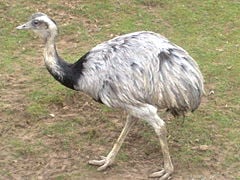 | ||||||||||||||||||
| Scientific classification | ||||||||||||||||||
| ||||||||||||||||||
| Rhea americana (Linnaeus, 1758)[1] | ||||||||||||||||||
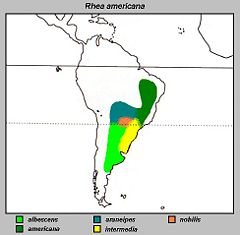 Distribution of subspecies
| ||||||||||||||||||
|
R. americana americana (Linnaeus, 1758)[1] |
The Greater Rhea (Rhea americana) is also known as the Grey, Common or American Rhea. The native range of this flightless bird is the eastern part of South America; it is not only the largest species of the genus Rhea but also the largest American bird alive. It is also notable for its reproductive habits, and for the fact that a group has established itself in Germany in recent years. In its native range, it is known as ñandú (Spanish) or ema (Portuguese).
Description
The adults have an average weight of 20–27 kg (44–60 lb) and 129 cm (51 in) long from beak to tail; they usually stand about 1.50 m (5 ft) tall. The males are generally bigger than the females, males can weigh up to 40 kilograms (88 lb) and measure over 150 cm (59 in) long.[3][29][21]
The legs are long and strong, and have three toes. The wings of the American Rhea are rather long; the birds use them during running to maintain balance during tight turns.
Greater Rheas have a fluffy, tattered-looking plumage. The feathers are gray or brown, with high individual variation, In general, males are darker than females. Even in the wild – particularly in Argentina – leucistic individuals (with white body plumage and blue eyes) as well as albinos occur. Hatchling Greater Rheas are grey with dark lengthwise stripes.[11]
Distribution, ecology and status
The Greater Rhea is endemic to Argentina, Bolivia, Brazil, Paraguay and Uruguay[12]. This species inhabits grassland dominated e.g. by satintail (Imperata) and bahiagrass (Paspalum) species[21], as well as savanna, scrub forest, chaparral, and even desert and palustrine[30] lands, though it prefers areas with at least some tall vegetation. It is absent from the humid tropical forests of the Mata Atlântica and planalto uplands along the coast of Brazil[31] and extends south to 40° latitude. During the breeding season (spring and summer), it stays near water.
A small population of the Greater Rhea has become established in Germany. Three pairs escaped from a farm in Groß Grönau, Schleswig-Holstein, in August 2000. These birds survived the winter and succeeded in breeding in habitat similar to that of their South American one. They eventually crossed the Wakenitz river and settled in Mecklenburg-Vorpommern in the area around and particularly to the north of Thandorf village.[32] As of the late 2000s the population is estimated to be 7 birds and in 2001 18 birds. In October 2008 the population was estimated by two German scientists at around 100 birds (Korthals, A. & F. Philipp).[33]
These rheas are legally protected in Germany in a similar way to native species. In its new home, the Greater Rhea is considered generally beneficial as its browsing helps maintain the habitat diversity of the sparsely-populated grasslands bordering the Schaalsee biosphere reserve.[34]
Lesser or Darwin's Rhea
| Darwin's Rhea | ||||||||||||||
|---|---|---|---|---|---|---|---|---|---|---|---|---|---|---|
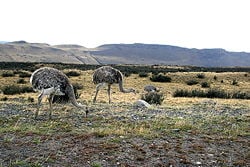 Nominate subspecies in Patagonia, Chile
| ||||||||||||||
| Scientific classification | ||||||||||||||
| ||||||||||||||
| Rhea pennata d'Orbigny, 1834[3] | ||||||||||||||
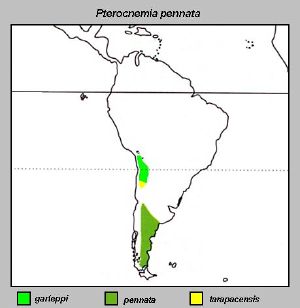 | ||||||||||||||
|
R. pennata garleppi (Chubb, 1913)[1] | ||||||||||||||
|
Rhea darwinii |
Darwin's Rhea, Rhea pennata, also known as the Lesser Rhea, is a large flightless bird, but the smaller of the two extant species of rheas. It is found in the Altiplano and Patagonia in South America.
Description
It stands at Template:Convert/to(-) tall and weighs Template:Convert/to(-),[3] and has larger wings than other ratites, enabling it to run particularly well. It can reach speeds of 60 km/h (37 mph), enabling it to outrun predators. The sharp claws on the toes are effective weapons. Their plumage is spotted brown and white, and the upper part of their tarsus is feathered.[3]
Behavior
The males of this species become aggressive once they are incubating eggs. The females thus lay the later eggs near the nest, rather than in it. Most of the eggs are moved into the nest by the male, but some remain outside, where they rot and attract flies. The male, and later the chicks, eat these flies. The incubation period is 30–44 days, and the clutch size is from 5–55 eggs. The eggs are Template:Convert/to(-) and are greenish yellow.[3] Outside the breeding season, Darwin's Rhea is quite sociable: it lives in groups of from 5 to 30 birds, of both sexes and a variety of ages.[3]
Distribution and habitat
Darwin's Rhea lives in areas of open scrub in the grasslands of Patagonia and on the Andean plateau (the Altiplano), through the countries of Argentina, Bolivia, Chile, and Peru.[14] It is known locally by various names, depending on the location: For example suri, choique, ñandú petizo, or ñandú del norte. All subspecies prefer grasslands, brushlands and marshland. However the nominate subspecies prefers elevations less than 1,500 m (4,900 ft), where the other subspecies typically range from Template:Convert/to(-), but locally down to 1,500 m (4,900 ft) in the south.[23]
Footnotes
- ↑ 1.00 1.01 1.02 1.03 1.04 1.05 1.06 1.07 1.08 1.09 1.10 1.11 Brands, S. (2008)
- ↑ An introduction to study of birds
- ↑ 3.00 3.01 3.02 3.03 3.04 3.05 3.06 3.07 3.08 3.09 3.10 3.11 3.12 3.13 3.14 3.15 3.16 3.17 Davies, S. J. J. F. (2003) Cite error: Invalid
<ref>tag; name "Davies" defined multiple times with different content Cite error: Invalid<ref>tag; name "Davies" defined multiple times with different content - ↑ 4.0 4.1 4.2 Davies, S.J.J.F. (1991)
- ↑ Gotch, A.T. (1995)
- ↑ Krulwich, R. (2009)
- ↑ Gotch, A.T. (1995)
- ↑ Nores, M. (2008)
- ↑ Remsen, Jr., J. V. (2008)
- ↑ Knox & Walters (1994)
- ↑ 11.0 11.1 11.2 11.3 11.4 11.5 11.6 Jutglar, F (1992)
- ↑ 12.0 12.1 12.2 12.3 12.4 12.5 12.6 12.7 Clements, J (2007)
- ↑ 13.0 13.1 Jaramillo et al. (2003)
- ↑ 14.0 14.1 14.2 14.3 14.4 BirdLife International (2008a)
- ↑ E.g. "Caribbean" Trumpet Tree (Tabebuia aurea): Schetini de Azevedo et al. (2006).
- ↑ E.g. Lebbeck (Albizia lebbeck), Añil (Indigofera suffruticosa) and Plathymenia foliolosa, including seeds: Schetini de Azevedo et al. (2006).
- ↑ E.g. Chan (Hyptis suaveolens): Schetini de Azevedo et al. (2006).
- ↑ E.g. Eugenia dysenterica and Psidium cinereum fruit: Schetini de Azevedo et al. (2006).
- ↑ E.g. Solanum palinacanthum and Wolf Apple (S. lycocarpum) fruit: Schetini de Azevedo et al. (2006).
- ↑ 20.0 20.1 Schetini de Azevedo et al. (2006)
- ↑ 21.0 21.1 21.2 Mercolli, C & Yanosky, A (2001)
- ↑ de Azevedo, C & Young, R (2006)
- ↑ 23.0 23.1 BirdLife International (2008b)
- ↑ 24.0 24.1 24.2 BirdLife International(2009)
- ↑ BirdLife International (2008)(a)
- ↑ Barlow 1963, p. 271–5.
- ↑ Darwin, C (1837)
- ↑ Herbert, S (1980)
- ↑ McFie, H (2003)
- ↑ Accordi, I & Barcellos, A (2006)
- ↑ Bencke, G (2007)
- ↑ Schuh, H (2003)
- ↑ International conference 'Invasive species - How we are prepared ? at the Brandenburgische Akademie „Schloss Criewen“, Criewen, Germany 2008
- ↑ Schuh (2003)
ReferencesISBN links support NWE through referral fees
- BirdLife International (2008a). Pterocnemia pennata. In: IUCN 2008. IUCN Red List of Threatened Species. Downloaded on 05 November 2008.
- BirdLife International (2008b). Lesser Rhea - BirdLife Species Factsheet. Data Zone. Retrieved 06 Feb 2009.
- Brands, Sheila (Aug 14 2008). Systema Naturae 2000 / Classification, Rhea pennata. Project: The Taxonomicon. Retrieved Feb 04 2009.
- (2007) The Clements Checklist of the Birds of the World, 6, Ithaca, NY: Cornell University Press. ISBN 978 0 8014 4501 9.
- Darwin, Charles (1837), Notes on Rhea americana and Rhea darwinii, pp 271–275 Proceedings of the Zoological Society of London 5 (51): 35-36
- Davies, S.J.J.F.. (2003). "Rheas". Grzimek's Animal Life Encyclopedia (2) 8 Birds I Tinamous and Ratites to Hoatzins: 69–74. Ed. Hutchins, Michael. Farmington Hills, MI: Gale Group.
- [1979] (1995) "15", Latin Names Explained. A Guide to the Scientific Classifications of Reptiles, Birds & Mammals. London: Facts on File. ISBN 0 8160 3377 3.
- Herbert, Sandra (1980), The Red Notebook of Charles Darwin, Bulletin of the British Museum (Natural History) Historical Series 7 : 1-164. Series 7: 1-164.
- (2003) Birds of Chile. London: Christopher Helm. ISBN 0-7136-4688-8.
- Krulwich, Robert (February 24, 2009). Darwin's Very Bad Day: 'Oops, We Just Ate It!'. National Public Radio. Retrieved June 6, 2009.
- Nores, Manuel (7 August 2008). Incluir Pterocnemia dentro de Rhea. South American Classification Committee. American Ornithologists' Union. Retrieved 04 Feb 2009.
Footnotes
References
- Accordi, Iury Almeida & Barcellos, André (2006): Composição da avifauna em oito áreas úmidas da Bacia Hidrográfica do Lago Guaíba, Rio Grande do Sul [Bird composition and conservation in eight wetlands of the hidrographic basin of Guaíba lake, State of Rio Grande do Sul, Brazil]. Revista Brasileira de Ornitologia 14(2): 101-115 [Portuguese with English abstract].
- Bencke, Glayson Ariel (2007): Avifauna atual do Rio Grande do Sul, Brasil: aspectos biogeográficos e distribucionais ["The Recent avifauna of Rio Grande do Sul: Biogeographical and distributional aspects"]. Talk held on 2007-JUN-22 at Quaternário do RS: integrando conhecimento, Canoas, Rio Grande do Sul, Brazil.
- BirdLife International 2008. [1]. 2006 IUCN Red List of Threatened Species., World Conservation Union. Retrieved on 04 Feb 2009.
- BirdLife International (2008(a)). Greater Rhea - BirdLife Species Factsheet. Data Zone. Retrieved 06 Feb 2009.
- Brands, Sheila (August 14, 2008). Systema Naturae 2000 / Classification, Rhea americana. Project: The Taxonomicon. Retrieved Feb 04 2009.
- (2007) The Clements Checklist of the Birds of the World, 6, Ithaca, NY: Cornell University Press. ISBN 978 0 8014 4501 9.
- Davies, S.J.J.F.. (2003). "Rheas". Grzimek's Animal Life Encyclopedia (2) 8 Birds I Tinamous and Ratites to Hoatzins: 69–73. Farmington Hills, MI: Gale Group.
- de Azevedo, Cristiano S. & Young, Robert J. (2006): Shyness and boldness in greater rheas Rhea americana Linnaeus (Rheiformes, Rheidae): the effects of antipredator training on the personality of the birds. Revista Brasileira de Zoologia 23(1): 202–210 [English with Portuguese abstract]. Digital object identifier (DOI): 10.1590/S0101-81752006000100012
- [1979] (1995) "Rheas", Latin Names Explained. A Guide to the Scientific Classifications of Reptiles, Birds & Mammals. New York, NY: Facts on File. ISBN 0 8160 3377 3.
- Jutglar, Francesc (1992): Family Rheidae (Rheas). In: del Hoyo, Josep; Elliott, Andrew & Sargatal, Jordi (eds.): Handbook of Birds of the World (Vol.1: Ostrich to Ducks): 84-89, Plate 2. Lynx Edicions, Barcelona. ISBN 84-87334-10-5
- Mercolli, Claudia & Yanosky, A. Alberto (2001): Greater rhea predation in the Eastern Chaco of Argentina. Ararajuba 9(2): 139-141.
- McFie, Hubert (2003): ACountryLife.Com – Something Rheally Interesting.
- Schetini de Azevedo, Cristiano; Penha Tinoco, Herlandes; Bosco Ferraz, João & Young, Robert John (2006): The fishing rhea: a new food item in the diet of wild greater rheas (Rhea americana, Rheidae, Aves). Revista Brasileira de Ornitologia 14(3): 285-287 [English with Portuguese abstract].
- Schuh, Hans (2003): Alleinerziehender Asylant ["Single-parent asylum seeker"]. Die Zeit, 2003-MAR-20 [in German, Google translation ].
- Brands, Sheila (August 14, 2008). Systema Naturae 2000 / Classification, Order Tinamiformes. Project: The Taxonomicon. Retrieved Feb 04 2009.
Further reading
- Accordi, Iury Almeida & Barcellos, André (2006): Composição da avifauna em oito áreas úmidas da Bacia Hidrográfica do Lago Guaíba, Rio Grande do Sul [Bird composition and conservation in eight wetlands of the hidrographic basin of Guaíba lake, State of Rio Grande do Sul, Brazil]. Revista Brasileira de Ornitologia 14(2): 101-115 [Portuguese with English abstract]. PDf fulltext
- Bencke, Glayson Ariel (2007): Avifauna atual do Rio Grande do Sul, Brasil: aspectos biogeográficos e distribucionais ["The Recent avifauna of Rio Grande do Sul: Biogeographical and distributional aspects"]. Talk held on 2007-JUN-22 at Quaternário do RS: integrando conhecimento, Canoas, Rio Grande do Sul, Brazil. PDF abstract
- BirdLife International (BLI) (2008). Rhea americana. In: IUCN 2008. IUCN Red List of Threatened Species. Downloaded on 05 November 2008.
- de Azevedo, Cristiano S. & Young, Robert J. (2006): Shyness and boldness in greater rheas Rhea americana Linnaeus (Rheiformes, Rheidae): the effects of antipredator training on the personality of the birds. Revista Brasileira de Zoologia 23(1): 202–210 [English with Portuguese abstract]. Digital object identifier (DOI): 10.1590/S0101-81752006000100012 PDF fulltext
- Jutglar, Francesc (1992): Family Rheidae (Rheas). In: del Hoyo, Josep; Elliott, Andrew & Sargatal, Jordi (eds.): Handbook of Birds of the World (Vol.1: Ostrich to Ducks): 84-89, Plate 2. Lynx Edicions, Barcelona. ISBN 84-87334-10-5
- Mercolli, Claudia & Yanosky, A. Alberto (2001): Greater rhea predation in the Eastern Chaco of Argentina. Ararajuba 9(2): 139-141. PDF fulltext
- McFie, Hubert (2003): ACountryLife.Com – Something Rheally Interesting.
- Schetini de Azevedo, Cristiano; Penha Tinoco, Herlandes; Bosco Ferraz, João & Young, Robert John (2006): The fishing rhea: a new food item in the diet of wild greater rheas (Rhea americana, Rheidae, Aves). Revista Brasileira de Ornitologia 14(3): 285-287 [English with Portuguese abstract]. PDF fulltext
- Schuh, Hans (2003): Alleinerziehender Asylant ["Single-parent asylum seeker"]. Die Zeit, 2003-MAR-20 [in German, Google translation ].
External links
- Rhea videos, photos and sounds on the Internet Bird Collection
Footnotes
References
- Brands, Sheila (Aug 14 2008). Systema Naturae 2000 / Classification, Family Rheidae. Project: The Taxonomicon. Retrieved Feb 04 2009.
- (2007) The Clements Checklist of the Birds of the World, 6, Ithaca, NY: Cornell University Press. ISBN 978 0 8014 4501 9.
- Davies, S.J.J.F.. (2003). "Rheas". Grzimek's Animal Life Encyclopedia (2) 8 Birds I Tinamous and Ratites to Hoatzins: 69–71. Ed. Hutchins, Michael. Farmington Hills, MI: Gale Group.
- Davies, S.J.J.F. (1991). in Forshaw, Joseph: Encyclopaedia of Animals: Birds. London: Merehurst Press, 47–48. ISBN 1-85391-186-0.
- (1994) Extinct and Endangered Birds in the Collections of the Natural History Museum, British Ornithologists' Club Occasional Publications. British Ornithologists' Club.
- (1835) An introduction to study of birds. London, UK: Chiswick.
- Remsen Jr., J. V.; et al. (07 Aug 2008). Classification of birds of South America Part 01:. South American Classification Committee. American Ornithologists' Union. Retrieved 04 Feb 2009.
External links
- Rhea videos on the Internet Bird Collection
Credits
New World Encyclopedia writers and editors rewrote and completed the Wikipedia article in accordance with New World Encyclopedia standards. This article abides by terms of the Creative Commons CC-by-sa 3.0 License (CC-by-sa), which may be used and disseminated with proper attribution. Credit is due under the terms of this license that can reference both the New World Encyclopedia contributors and the selfless volunteer contributors of the Wikimedia Foundation. To cite this article click here for a list of acceptable citing formats.The history of earlier contributions by wikipedians is accessible to researchers here:
The history of this article since it was imported to New World Encyclopedia:
Note: Some restrictions may apply to use of individual images which are separately licensed.

